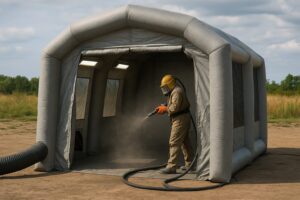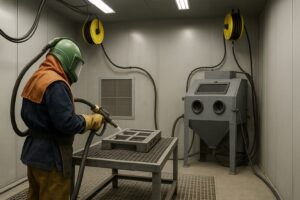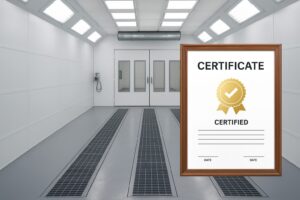Sandblasting is a powerful process used to clean, smooth, or shape surfaces by propelling abrasive materials at high speed. While it’s essential for industries like automotive refinishing, metal fabrication, and construction, sandblasting generates a considerable amount of dust and debris. If left unmanaged, this can pose serious health risks and affect the quality of work. That’s where sandblasting booths come in, designed specifically to control dust, debris, and hazardous particles during blasting operations.
Managing dust and debris effectively in a sandblasting booth is not just about meeting safety regulations—it’s also about ensuring maximum efficiency and longer equipment life. But how do these booths keep everything under control? Let’s explore the key ways sandblasting booths handle dust and debris.
Enclosed Environment for Containment
The first and most obvious feature of a sandblasting booth is its fully enclosed design. The booth’s walls, roof, and floors form a sealed environment, preventing dust and abrasive particles from escaping into the surrounding workspace. This containment keeps the blasting area safe and minimizes the spread of contaminants.
High-quality booths are made with durable materials that can withstand the high-speed impact of abrasive particles. The enclosed environment also helps maintain visibility, reducing the chances of operator error. Some advanced booths even have soundproofing features to reduce noise levels, making the workplace safer and more comfortable.
Dust Collection Systems
Central to managing dust and debris is the dust collection system. These systems use high-powered fans and filters to capture airborne particles generated during sandblasting. As the abrasive hits the target surface, fine dust is produced, which could be harmful if inhaled or left to settle on equipment.
Dust collectors pull in the dusty air and pass it through specialized filters that trap even the finest particles. Clean air is then released back into the environment, ensuring compliance with workplace air quality standards. Depending on the booth’s size and intensity of operation, dust collectors can range from compact units to large-scale filtration systems.
Air Ventilation and Extraction
Effective airflow management is essential in sandblasting booths. Proper air ventilation ensures a continuous flow of clean air into the booth while extracting dust-filled air. This airflow typically follows a cross-draft or downdraft pattern.
In a cross-draft system, air moves horizontally across the booth, pushing dust toward the filters. In a downdraft system, air flows from the ceiling down to the floor, capturing dust particles as they fall. Both systems help maintain visibility, improve operator comfort, and enhance overall blasting efficiency.
Abrasive Recovery Systems
Another crucial feature in sandblasting booths is the abrasive recovery system. When abrasive materials hit the target surface, they break down into smaller particles and mix with debris. Instead of letting this mixture accumulate on the floor, recovery systems automatically collect and separate reusable abrasives from waste material.
There are two main types of recovery systems: mechanical and pneumatic. Mechanical systems use conveyors, augers, or bucket elevators to transport used abrasives to a recycling unit. Pneumatic systems use suction to pull abrasives into a recovery unit. Both systems reduce material waste and keep the work area cleaner.
Floor Design and Grating
The booth’s floor design also plays a significant role in managing dust and debris. Floors are typically made with heavy-duty grating that allows spent abrasives and debris to fall through. Beneath the grating, a collection system gathers the material for recycling or disposal.
This design prevents build-up on the working surface, reducing the need for manual cleaning and keeping the operation running smoothly. Some booths feature fully automated floor systems that continuously collect and process debris without operator involvement.
Filtration and Maintenance
Filtration systems in sandblasting booths are designed to trap hazardous dust particles, including silica, metal shards, and other contaminants. Filters must be cleaned and replaced regularly to maintain optimal performance. Advanced filtration units often come with automatic cleaning systems that reduce maintenance needs.
Proper maintenance is essential to ensure that dust management systems work as intended. This includes inspecting filters, checking airflow levels, and ensuring all components are functioning efficiently. Well-maintained booths provide better dust control, reduce downtime, and extend the lifespan of the equipment.
Health and Safety Compliance
Managing dust and debris is not just about keeping the workspace clean—it’s also a matter of health and safety compliance. In many industries, exposure to dust from materials like silica, aluminum, and steel can cause severe respiratory issues. Sandblasting booths are designed to meet occupational safety and health standards by limiting airborne dust and maintaining safe air quality levels.
Many booths come equipped with features like automatic shutdown systems and emergency ventilation in case of equipment failure. Operators are also required to wear personal protective equipment (PPE), including respirators, protective suits, and gloves, to minimize exposure.
Conclusion
Managing dust and debris in a sandblasting booth is a multi-layered process involving containment, ventilation, filtration, and recovery systems. Each component works together to create a safer, cleaner, and more efficient workspace.
By using high-performance dust collection systems, well-designed airflows, and effective abrasive recovery units, sandblasting booths ensure optimal productivity while protecting both workers and the environment. Regular maintenance and adherence to safety guidelines further enhance their effectiveness, making them an indispensable tool in industries where surface preparation is a critical part of the process.
Specialized Sandblasting Booth Services
We specialize in providing top-quality sandblasting booths and custom finishing solutions tailored to meet the unique needs of various industries. Our expert team designs and manufactures state-of-the-art sandblasting booths that ensure safety, efficiency, and superior performance. From automotive and aerospace to marine and industrial applications, our booths are engineered to handle even the most demanding surface preparation tasks. We offer comprehensive services, including booth installation, maintenance, upgrades, and technical support.




